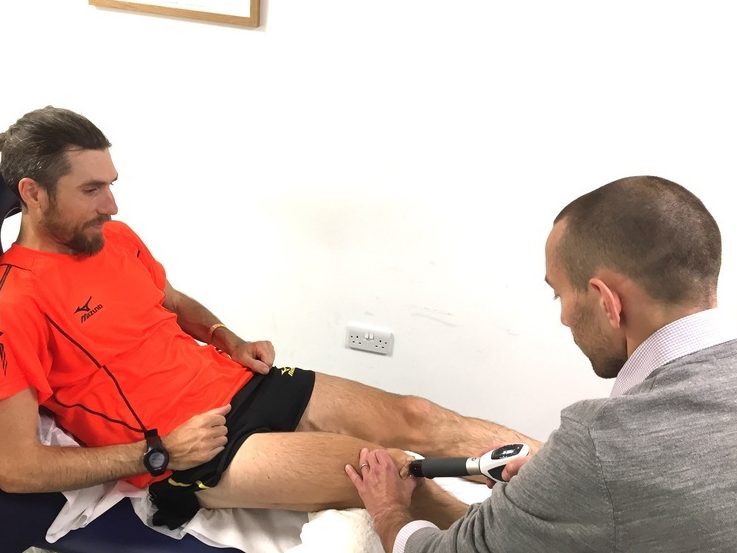Shockwave therapy: how it can help runners
Shockwave therapy has been in use for the past 30 years but, arguably, has only become widely used in the treatment of muscle-tendon problems over the past 10 years.
The most common form of shockwave therapy used clinically are radial shockwaves which are high-energy acoustic waves. They are transmitted through the surface of the skin and spread radially into the affected area of the body. The body responds by increasing metabolic activity around the treated site to encourage and expedite a natural healing process.
I have been lucky enough to use shockwave therapy in my clinical practice over the past 8 years and whilst it definitely isn’t a ‘silver bullet’ or a ‘cure all’, I have seen it turn around a number of cases of stubborn plantar fasciitis, Achilles and patella tendon problems and seemingly expedite the recovery of a number of problems (including my own) in this time. The purpose of this article isn’t to provide a systematic review of the evidence but to highlight the potential benefits of shockwave therapy to those who may not be aware of its usefulness. If you’re interested in the science, I’ve provided a couple of links to some systematic reviews discussing shockwave therapy.
What is shockwave therapy used for and is there any decent evidence for it?
There is growing evidence that support the efficacy of shockwave therapy in both upper and lower limb musculoskeletal disorders such as calcific tendinitis in shoulders, ‘tennis elbow’, gluteal, patella and Achilles tendinopathy as well and plantar fasciitis (or plantar fasciopathy).
What are the advantages of shockwave therapy?
There’s a good argument for using shockwave instead of choosing a steroid injection or surgery. We know that corticosteroid injections (CSI) can sometimes degrade the integrity of tendon (and they are sometimes referred to as ‘tendon toxic’ in recent literature, particularly when used repeatedly). For this reason, it’s generally considered inappropriate to use corticosteroid to treat load-bearing tendons such as the Achilles.
Shockwave therapy can, however, be administered directly to load bearing tendons with almost no side effects on the integrity of the tendon structure. From a sporting perspective, there does not need to be a significant abstinence from activity, which also means that it can be used alongside exercise-based interventions and competition. At most, we might recommend a 48 hour rest period post-treatment, (as opposed to 5-7 days having undergone a steroid injection, or weeks in the instance of surgical interventions).
In my practice, I’ve used shockwave therapy to great effect in both elite and non-elite marathon runners, as a very useful adjunct to more ‘traditional’ physiotherapy treatment. Paul Martelletti (pictured below) is an elite 2:16 marathoner who routinely runs in excess of 140 miles per week, has found shockwave therapy a very useful treatment to help keep him running and manage a number of injuries including a proximal hamstring tendinopathy, plantar fasciitis and more recently patella tendinopathy without disrupting his training. A 2014 systematic review by Mani-Babu et al supports the adjunctive role of shockwave therapy noting that:
‘It is evident that there are enough high-quality studies evaluating the effectiveness of ESWT and it is evident that ESWT can play a role in the treatment of patients with lower limb tendinopathies alongside progressive loading and flexibility management’
Paul Martelletti, 2:16 Marathoner receiving shockwave therapy for patella tendinopathy
What are the disadvantages of shockwave therapy?
Shockwave therapy can be a little bit uncomfortable, sometimes even painful – particularly for the first minute of application (a session will last typically no longer than 5 minutes). A course of shockwave therapy will involve at least 3 to 6 sessions typically administered 5-10 days apart. Whilst some patients do report instant ease of symptoms, commonly it can take a few weeks for improvement in symptoms to be observed. It is important to that it isn’t guaranteed to work for everyone, but it is a much less invasive and risky treatment option than steroid injection or surgery.
There are a small group of patients for whom shockwave therapy would not be suitable on the grounds of safety. The following are generally considered be contraindications to shockwave therapy:
- Steroid injection in the past 3 months
- Tendency to haemorrhage
- Patients taking anti-coagulant therapy
- Haemophiliac patients
- Acute inflammation of the treatment area
- Tumour at the treatment site
- Infection of the treatment area
- Pregnancy
- Severe circulatory disorder
- Nerve disorder at treatment site
- Open wound at the treatment site
- Prosthesis
- Cardiac pacemaker
Want to find out more or book an appointment?
If you want to find out more about shockwave therapy or to book an appointment with Scott at the please contact Scott via email at [email protected], or book an appointment online via the link here.



